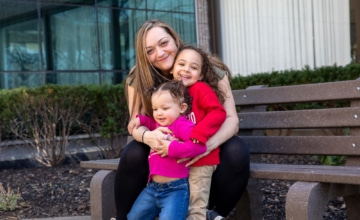It is around this time—when the super-intense months of babyhood are behind you—that some parents or partners realize that they have drifted from the closeness they shared “Before Baby.” Browse the information and links below to see what your little one is experiencing and learning this month.
What It’s Like for You
It can be helpful to talk through with your partner all that has changed since the arrival of your baby—the joys and the challenges. Even an amazing change like having a baby brings about other changes that can be hard to adjust to.
Says James, father of Sierra, 8 months: The other day I was (half) joking with my wife about whether we were ever going to have sex again. She didn’t think it was very funny. The thing is, it’s not just about the sex. It’s more like things aren’t easy between us anymore. It’s just not the same as it was before Sierra. We’re so tired, and Sierra hates being left with a babysitter, so we hardly ever go out. I just don’t feel like my wife and I are connected like we used to be.
Many parents find themselves stumbling through this period and discovering that there’s some distance between them. This is not unusual, or the sign of a “bad marriage.” Instead, it is the common result of months of “parent fatigue”—lack of sleep, few breaks, frayed nerves, and short tempers. When you can discuss how things have changed (those changes you like and the ones you don’t) without anger or accusation, you and your partner can begin exploring different ways for each of you to get your needs met. Sometimes a counselor, a clergy member, or a family support group (where you can hear and learn from others’ experiences) can be a real help in figuring this out. While emotional and challenging at times, communicating with your partner about these issues can actually lead to feeling closer and more connected than ever before.
What It’s Like for Baby
I just finished my bath. Daddy has rubbed that good-smelling lotion on and he’s fastening my diaper. Next, he will put on my pajamas. Then I bet he will brush my teeth. I don’t like that part. I keep trying to tell him to stop…I move my head back and forth so he can’t get the toothbrush in, and I try to keep my mouth closed. But he keeps saying, We have to brush teeth to keep them healthy and strong.
Then comes my favorite part. Mommy and Daddy cuddle with me and read me stories. And sometimes I clap while Mommy and Daddy sing together. If they forget, I start clapping. They laugh and say, Is it time to sing? And they choose my favorite song: Over in the meadow… Then comes the part I don’t like. Daddy says, Time for bed, kiddo! And he lifts me up and puts me in my crib. I stand right up so he knows I don’t want to go to bed. I babble and babble to try to tell him not to go. I want to stay and cuddle with them longer. But they say, Night-night. I know what that means—playtime is over. Guess I better lie down and go to sleep.
What Your Baby Is Learning
Social-Emotional Skills:
- Self-esteem—as she senses that she is fun to be with
- Relationship-building that connecting with others is a source of love and nurturing
- Security as the bedtime routine makes her feel that the world is a safe and predictable place
- Trust—that her parents may leave but they always come back
- Coping with limits as she learns how to handle her feelings when she has to do something she doesn’t want to, like tooth-brushing.
Language and Thinking Skills:
- That she can communicate using her body and gestures
- The meaning of words, like “sing,” “toothbrush,” and “night-night”
- Object permanence—that even though she can’t see her parents any more, they are still there somewhere
- Figuring out what things are and what they do, for example when she recognizes the toothbrush, understands its purpose, and “gets” how it is used…then promptly clamps her mouth shut!
Physical Skills:
- How to clap
- How to use her body to “get away” from the toothbrush
- How to pull up, balance, and stand up in the crib
What to Expect From Your Baby’s Development
As you review the chart, keep in mind that development is not a race and that every child grows at her own pace and in her own way. Your child may develop skills faster or slower than indicated below and still be on track. If you have questions or concerns, talk with your child’s health care provider or other trusted professional.
Your Toddler’s Development From 9 to 12 Months
| What Your Baby Can Do | What You Can Do to Connect With Your Baby |
|---|---|
I can understand more words than I can say. |
|
|
|
I may become more choosy about the foods I’ll eat. |
|
|
|
I can creep and crawl. |
|
|
|
I know that things still exist even though I can’t see them—especially you! |
|
|
|
I love to do things over and over again. |
|
|
|
Did You Know…
By 9 months, babies seek out interaction with their mothers by smiling at them to get their attention? This shows that babies are developing social skills—as they make efforts to engage others—and an understanding of the “back and forth” of relationships.
What the Research Means for You
Your baby is learning so much from you. He has been watching you make all sorts of efforts to engage him all these months and now he is using those same tactics to initiate interaction with you and others. This is a very powerful role you play—supreme role-model. When you comfort your baby when he falls, he is is learning to accept love and caring from others, and how to soothe himself. When you laugh together at the sound your baby’s rattle makes, he learns how good it feels to share discoveries with someone else. By spending time and having fun together, you tell your child just how special he is.
Spotlight on: Clapping, Waving, and Pointing
Put Your Hands Together
By 9 months, many babies are big into clapping. They may clap to show excitement, happiness, or to get your attention. They may also clap because they see you clapping, or because they have learned that when they clap, you smile and focus your attention on them. Clapping—like most body movements babies make—is a way that your baby is communicating and connecting with you.
Do the Wave
Babies are making lots of progress in the way they use their hands and fingers. Very soon now your baby will start to wave—and most likely she will do it for the first time when someone is leaving or arriving. Think about what an amazing milestone this is: By watching the people all around her, she has figured out that waving is what you do when someone is coming or going. If, while you wave, you also say Hi or Bye-bye, you help your baby connect the situation, the gesture, and the meaning of the words.
Point It Out
Another exciting new “trick” that you may see this month (or in the coming months) is pointing— a major milestone. Even though babies this age are not yet using many (if any) words, pointing is a very powerful and effective communication. In this small gesture, a baby is “saying”: Look at what I see. I want you to look at it too. Or, See that train up on the shelf; can you get it down for me? I want to play with it.
Pointing helps babies get your attention and connect with you. It also helps build language skills. Your baby points at the mirror. You say, That’s the mirror. Who is that cute baby in the mirror? It’s you! She points at the squirrel outside. You say, See the squirrel? He is jumping on the fence. Squirrels like to eat nuts. That squirrel is probably trying to find a nut. Your baby starts to learn about new words, objects, and ideas just by pointing. So when your baby points it out, take some time to talk it out!
Let’s Play: Activities That Nurture Bonding and Learning
Fill ‘er Up
Tape the top of an empty, clear plastic container (like a tennis ball can) to ensure there are no sharp edges. Gather together some small blocks (or other toys) and show your child how to drop the blocks into the canister. See if he’d like a try. When the canister is full, show your child how he can knock or dump it over and empty it out.
Humpty Dumpty
Hold your child securely on top of a beach ball or exercise ball. Say, Humpty Dumpty sat on a wall (bounce your child gently), Humpty Dumpty had a great fall (holding her carefully, slide her off the ball). All the king’s horses and all the king’s men, lifted Humpty back up again (put her back on the ball, bouncing gently). End with a kiss for your good little egg!
What’s on Your Mind
1. My baby is 9-months-old and I just found out that I have to go on a 2-week business trip. My husband and our nanny will be there to care for her, but I’m still worried about how this separation may affect my daughter and our relationship.
Your worry is understandable. It is very hard to leave a baby at such a young age, but it is something so many working parents are faced with these days. It’s hard to predict exactly how your baby will react because every baby is different. Some babies are more flexible and make changes easily. Other babies have a hard time with change and may have a bigger reaction. Either way, if your baby has developed strong, stable relationships with her Dad and her Nanny, the separation will likely be easier.
The good news is that by 9 months, most babies understand that things they cannot see still exist. That is why, at this age, babies protest when they are separated from loved ones (also known as separation anxiety). This means that your baby can now picture you in her mind. And she will surely recognize you when you return.
There is a lot you can do to help make this separation easier for your baby:
- Take some photos of you and her together. Have her Dad and Nanny show them to her while you are away.
- Make some audiotapes of you singing and reading to her that she can listen to while you are gone. You can even make the tapes together as you read her a favorite book. Record what she “says” too.
- Call her every day so she can hear your voice.
- Have her Dad and Nanny keep her routine as normal as possible. When there is a big change in a baby’s life, it is important that the rest of her world stay as stable as possible.
Dad and Nanny should expect that your daughter’s moods may change throughout the 2 weeks. She may withdraw, be clingy, cranky, and more demanding. If she rejects their care at times, they should not take it personally. All of these behaviors are her attempts at coping. It’s important to stay patient, comforting, and consistent.
How might your daughter react when you return? Babies respond to separations in very different ways, all out of a deep love for their parent. For example, babies often break down when seeing a parent again after a separation. It’s as if they are saying, You have been gone so long! I want you with me always and I am really mad at you for leaving! These are natural and expected feelings from a young child. It doesn’t mean you did something bad. Separations are a part of all our lives, and helping your child learn to cope with them is a gift you give your daughter.
How you handle your daughter’s reaction is very important. It is not uncommon for children to reject the parent who has been away and cling to the caregivers who have been around (i.e., dad and her Nanny). This can naturally be quite upsetting, and elicit hurt feelings, guilt, anxiety, and even anger. All are normal. But remember: You did not harm your relationship with your daughter. She is simply coping with a confusing situation (Mommy was here, then gone, then here—will she disappear again?) What you can do is let her know that you love her and accept her feelings (happiness, distress, ambivalence, anger, or sadness) no matter what. As you get back to your normal routine and she experiences that all is well and nothing has changed, she will be back to her old self. Remember that your sensitive, loving support is teaching her that she can show you her true feelings and you will still love her and be there for her…always.
2. My 9-month-old and I are in a Mommy and Me Music Class, but he’s scared to participate. By the end of class, though, he’s getting into it a little bit. Should I keep attending?
Stick with it. You’re making important progress. While some children naturally go-with-the-flow and jump right into new situations, others are slower to warm up. They tend to be more comfortable in one-on-one experiences and can feel easily overwhelmed in a group. Another factor may be your son’s sensitivity to sounds. He may love hearing music at home, but in a class, the noise and movement of the other children may at first be too much for him.
Here’s how you can help your son feel safe and find pleasure in new relationships and experiences:
- Play with musical instruments at home and gradually add different sounds.
- Invite another child around your son’s age to come over so he can get used to spending time with other children. Ideally the child should be familiar to your son and be a good “fit”, i.e., easy to get along with.
- Give him opportunities to feel comfortable in group situations by attending other organized activities like play groups or story time at the library.
- If possible, arrive at the music class early to give your child a chance to explore the room without others around.
- When in new or group situations, follow your child’s lead. If he clings to you, help him explore from the safety of your arms or lap. * If he needs a break, take a stroll around the room or go to a quiet area. If you give him the time and support he needs, he will soon feel safer to join the fun.
3. My 9-month-old loves to throw food on the floor. He tosses it, then he looks at me, then he giggles. It’s cute for a while but then it’s really annoying. How can you start to set limits with a baby this young?
The “Food Fling” game is quite common. Nine-month-olds are driven to learn how the world around them works. When your son is throwing his apple slices off the high chair tray, he is figuring out: Where does the apple go? Does it always fall on the floor? Can I make it come back? What sound does it make? What happens to it after it falls—does it bounce, splat, or squash?
At 9 months, you set limits by stopping unacceptable behavior and offering other ways for your child to explore that are acceptable. The less emotional and more matter-of-fact you are when you set the limit, the more likely the behavior will stop. The more intense your reaction—positive or negative—the more rewarding it is for your child and the more likely he will continue the behavior. So avoid raising your voice or getting into a battle about it. And, although it’s tempting, try not to laugh or smile or give your child signals that you enjoy the game. This can be confusing to him.
When your baby starts to throw food, keep your expression neutral (no smile, no frown) and say, No throwing. If he continues tossing food, simply take it off the tray and say (again, matter of factly and without anger), I guess you are all done. Then take him out of the high chair and offer him objects he can drop or throw (such as a foam ball) in a place that is acceptable to you—such as in a playroom or outside.
If you do this consistently, he will put two and two together and learn that food throwing in the high chair means the food goes away. (If you are concerned that he hasn’t eaten enough, offer a healthy snack soon after. If he’s hungry, he’ll eat.) By reacting in this way, you are teaching your child very important life lessons: how to cope with disappointment when he can’t always get his way, and how to find acceptable means for getting his needs met.
4. Why is my child so interested in touching and mouthing toys? I thought that by now, she’d be doing more playing.
For your baby, that’s just about the most fun she can have! By 9 months, babies really enjoy and are getting quite good at exploring objects with their eyes, hands, and mouths. These explorations are guided by their curiosity about: What is this? What does it feel like in my hands and in my mouth? What does something that looks like this feel like?”
Take the example of a baby picking up and mouthing a block. As an adult we know (or can imagine) exactly what the various characteristics of a block are. There is a smooth surface, it is shaped like a cube, it is the size of a small box, it has edges that feel different than the flat sides, etc. While for adults this knowledge is almost automatic, babies are delighted by the discovery of the physical features of objects. They are equally interested in the connection between sights and sensations—that a side that looks smooth also feels smooth in the mouth and hands. When holding and putting the cube in her mouth the baby learns about features such as smoothness, coolness, side, edge, and corner.
If you watch your baby closely enough, you can see these discoveries happen as she moves the cube around in her hands, puts it in her mouth, takes it out and looks at, puts it back in, and so forth. Watching for this, and gently supporting and guiding your baby, can also be delightful for you. It’s exciting to “get” what your baby is up to while she is playing: Oh, it looks like you found the edge.
This process is essential for later learning. Imagine if, as a preschooler, your child had to suck every wooden block she was stacking in order to figure out which was the edge and which was the side. Instead, after having explored blocks over and over again, your child comes to expect that each block will have the same basic characteristics. By mouthing and handling objects as a baby—safely, of course—she becomes “fluent” in ideas like side, edge, and corner. She doesn’t have to “re-discover” blocks each time she plays. This enables your child to automatically apply this knowledge to solve more and more complex problems, like how to build a block tower.
This response was developed in partnership with Robert Weigand, Director, Child Development Laboratory Arizona State University.
5. Why is “drop the spoon” such a fun game for babies?
Through exploration, babies are learning about the objects in their world. They are very curious about questions like, What can I make this thing do? Can I make it do that again? So…they bang, drop, toss, and squeeze. What babies learn through this experimentation is that the same action can lead to different consequences. Each time I drop the spoon over the side of the high chair, it falls to the floor and makes a noise. But it makes a different sound and ends up in a different place each time. Babies repeat actions over and over again until they are convinced that, indeed, every time it will be different in some ways and the same in some ways.
Through games like this, babies begin to develop rules about objects. When I drop an object, it will make a noise and land out of reach—though the noise and final location will vary a bit each time. And, they learn over time that this rule will hold true not just for the spoon, but for the bowl, and the cup, and the rattle. Babies are fascinated by learning this rule. In addition, learning new concepts through play builds self-confidence and self-esteem: I’m a good problem-solver. And most importantly, babies learn that learning is fun.
This response was developed in partnership with Robert Weigand, Director, Child Development Laboratory, Arizona State University.
Expert Reviewers
- Terrie Rose, PhD, President and Founder, Baby’s Space
- Ross Thompson, PhD, Professor of Psychology, University of California at Davis
- Robert Weigand, MS, IMH-E, Director, Child Development Laboratory, Arizona State University
This ZERO TO THREE newsletter series was made possible by generous funding from the MetLife Foundation.
*Additional reporting by Claire Lerner





